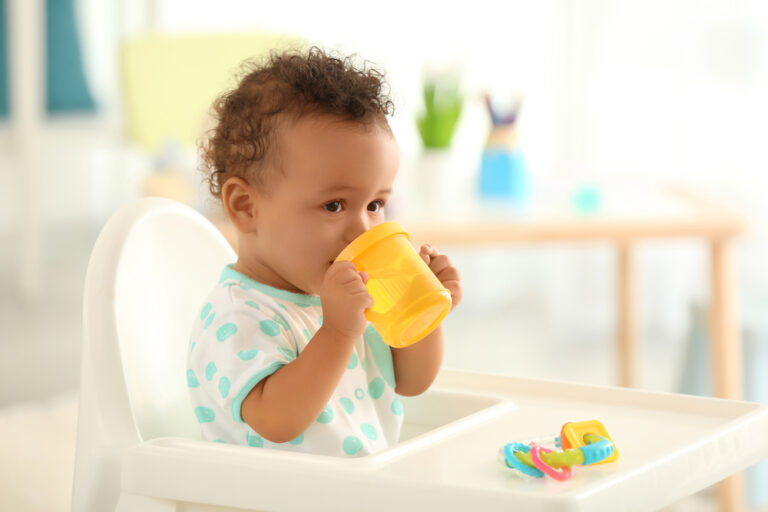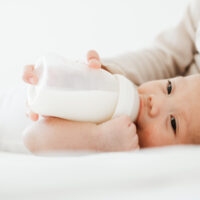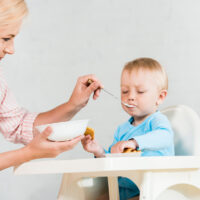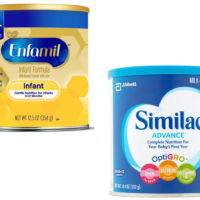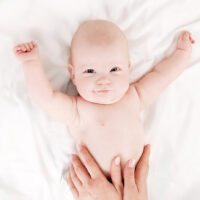Learning to drink from a sippy cup is a major food milestone. In fact, it’s generally recommended you start introducing a sippy to your baby as early as six months, once you start solids. Most babies learn to drink from a sippy cup pretty easily. Below, we’ll take a look at how to teach baby to drink from a sippy cup and answer some questions you might have about it.
Introduce Sippy Cups Early
Start introducing your baby to sippy cups when you introduce solid foods. You should only put a small amount of liquid in the cup. Early introduction isn’t about getting your baby to drink from the cup. Instead, the goal is to create positive associations with eating and drinking.
Even though your baby likely can’t drink from the sippy cup yet, introducing the cup early familiarizes them with it. It’s best to introduce your baby without the lid on it at first. Instead, put a small amount of liquid (no more than 1-2 tablespoons) in the cup. Help your baby raise it to their lips and get a small taste of the drink inside.
RELATED: The Best Sippy Cup: Taking Babies and Toddlers from Bottle to Cup
Choosing the Right Sippy
Like your baby had to learn to eat from a bottle or latch to your nipple after birth, they’ll need to develop the skill to drink from a sippy. Like bottles, sippy cups come with a recommended age guidance from the manufacturer that you should follow.
For younger babies, a sippy cup that is softer usually works best. Some are designed with spouts and others have straws instead. There’s even a sippy cup from Munchkinthat has a 360-degree design, letting your baby drink from the cup on any side like they would a normal cup but with a lesser risk of spilling.
Some parents have better luck being persistent with one cup, while other parents like to offer a variety to see what works best. You can learn more about some of our recommendations for the best sippy cups here.
Consider Trying Silicone First
Even though there are many styles of sippy cups, many parents have luck using something with a silicone nipple. Many baby bottles have nipples made from silicone since silicone is durable, non-toxic, and flexible. This makes the transition easier. For babies that are breastfed, a softer silicone cup mimics the natural feeling of the breast and might make it easier for your baby to learn.
Another benefit of silicone is that it is very flexible. When your baby is learning to suck to get liquid out of the cup, the flexible material makes it easier for them to get to their drink.
Use a Gradual Approach
Don’t rush your baby to start drinking from the cup. Generally, the earliest interactions with the cup should be about developing the skill, rather than satisfying your baby’s thirst. Even raising the cup to your baby’s lips helps them use the muscles that they’ll need to eventually drink from the sippy cup.
After you’ve gotten your baby used to the sippy without the lid, you can try using it with the lid. If your baby’s sippy cup has an internal valve that stops it from flowing easily, you can try removing that at first. This lets the liquid flow more freely, so your baby needs less suction as they get familiar with how to use the cup.
However, you’ll want to be sure you don’t put too much liquid inside the cup. Otherwise, it can flow too quickly and cause your baby to gag on the liquid. This is unpleasant for them and might discourage them from using the sippy for a while.
Stimulate the Suckling Reflex
When your baby feeds from your breast or a bottle, the nipple touches the roof of their mouth. When this happens, it stimulates the suckling reflex. You can gently touch the nipple of the sippy cup to the roof of your baby’s mouth to try and make it easier for them to take the sippy cup spout.
Some parents have also started by putting the bottle in their baby’s mouth and then switching it out for the sippy. This is something else you can try if your baby is being stubborn. You can dip the spout in a little breast milk or formula first to entice your baby, too.
Offer Something Other Than Water
Once your baby is six months old, it is okay to start giving them juice (though you shouldn’t give them too much juice, since it adds calories without the same nutritional benefits as breast milk or formula). When you are first introducing the sippy cup, however, your baby is likely to be more interested in milk or juice than water in their cup. If your baby is more interested, it’s more likely they will try to get the drink out.
Something to note is that you should only offer a small amount of water or juice. Too much water or juice takes up room in your baby’s tummy without offering any calories. Your baby will still need to take in primarily formula or breast milk as liquid in their first year. If you are going to offer juice, you should also water it down slightly so it isn’t as sugary.
RELATED: When Can I Give My Baby Juice?
Phase Out Bottles Completely
Once your baby is using the sippy cup well, it’s best to stop using bottles altogether. It does not matter how old your baby is once they are over six months. As long as they are eating well, you can switch out their sippy cups for all types of feedings.
Some parents also have luck with quitting bottles cold turkey. This is especially true if you have tried strategies on how to teach your baby to drink from a sippy cup and haven’t had any luck. You should expect some resistance or frustration from your baby if you quit cold turkey. However, instead of offering a bottle, you’ll use a sippy cup for all feedings. If your baby is struggling, you can also use the open cup strategy to feed them.
RELATED: When to Stop Formula (and Other Formula Feeding Tips)
Continue to Transition to a Regular Cup
Even though a sippy cup isn’t the same as a bottle, it poses some of the same problems when it comes to jaw and tooth misalignment when it’s overused. It’s also very easy for your baby to get attached to their sippy cup, which might make it harder to wean later on.
You should never let your child take a sippy cup to bed, especially one filled with juice or formula/milk. Additionally, try to wean your baby from the sippy cup in the toddler years. It can be helpful to use cups around him/her and encourage your toddler to drink from a cup, too. Most children are ready to drink from a regular cup by the time they are two years old.
FAQs – How to Teach Baby to Drink from a Sippy Cup
When should I introduce a sippy cup?
You should introduce a sippy cup to your baby around the same time you introduce solid foods. For many babies, this is as early as six months. Once your baby is sitting up on their own, it’s also a good indicator that you should start introducing a sippy cup or open cup.
Even though babies don’t always drink from a sippy cup at six months, introducing it earlier makes the transition easier in the future. It also gives your baby a chance to create positive relationships regarding eating/drinking and their sippy cup.
Why should baby learn to drink from a sippy cup?
Learning to drink from a cup or sippy cup is important because it helps your baby transition from a bottle. There are many reasons that you should make the transition. The most important is that using a bottle affects the way your baby’s mouth, jaw, and tongue muscles develop. This causes problems like misalignment, overbite, and even speech problems.
Bottle feeding past your baby’s first birthday also makes it harder for them to switch. Babies older than one year often start to form habits. Additionally, babies start forming their own opinions about things by the time they are two. If they have a strong opinion about using a bottle, it’s going to be significantly harder to make the switch.
Finally, bottle feeding too long may also affect your child’s relationship with food. This might lead to conditions like obesity later in life, especially if your baby is encouraged to finish their bottle when feeding. Their preference for bottle-feeding also may cause picky eating and poor nutrition. Additionally, bottle feeding at night leaves sugars on your baby’s teeth that promote tooth decay.
Final Word
Introducing your baby to a sippy cup when they are young helps make transitioning away from a bottle significantly easier. Most babies are even ready to be introduced by six months. Hopefully, these strategies on how to teach baby to drink from a sippy cup will make taking those first steps much easier.
